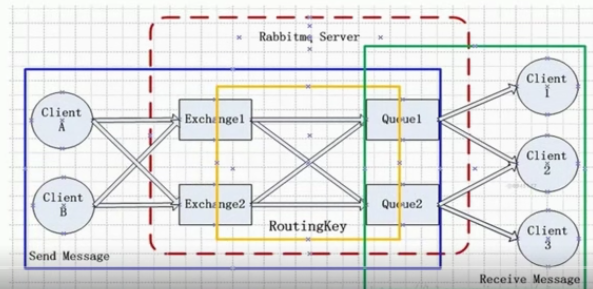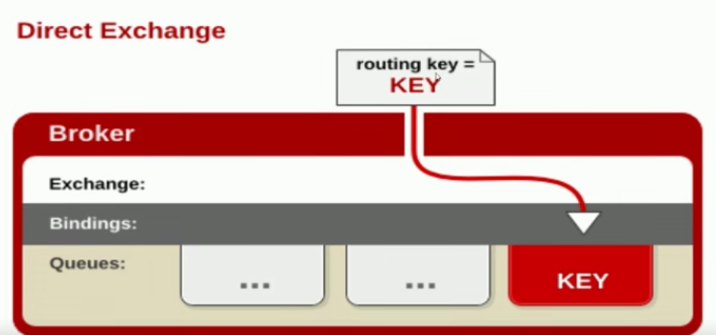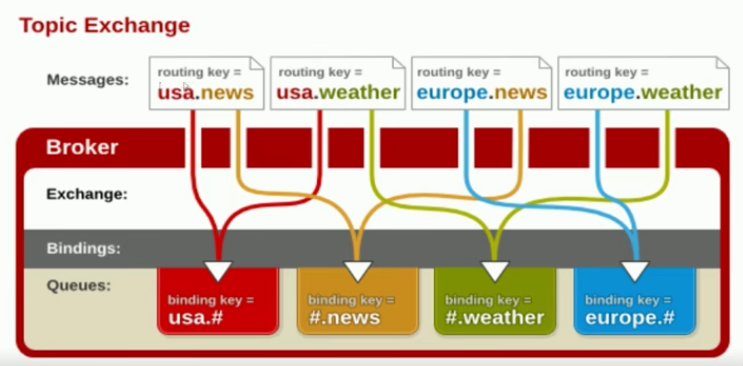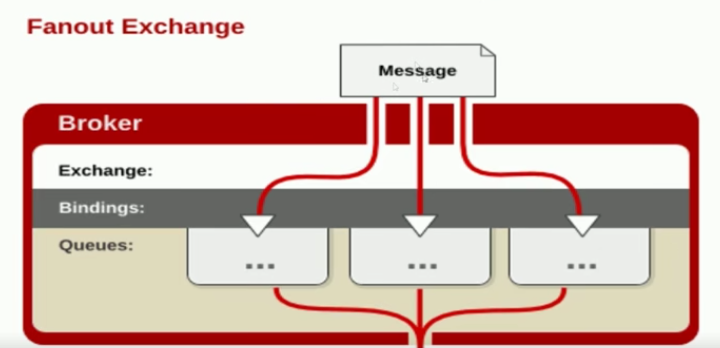Exchange:接收消息,并根据路由键转发消息所绑定的队列
ClientA,B将消息投递到交换机Exchange上,通过路由关系,投递到指定的queue1或者queue2上,通过监听投递到Client1...

交换机属性:
Name:交换机名称
Type:交换机类型direct、topic、fanout、headers
Durability:是否需要持久化,true为持久化
Auto Delete:当最后一个绑定到Exchange上的队列删除后,自动删除该Exchange
Internal:当前Exchange是否用于RabbitMQ内部使用,默认为false
Arguments:扩展参数,用于扩展AMQP协议自制定化使用
有直连对应关系的连接方式:
Direct Exchange:所有发送到Direct Exchange的消息被转发到RoutKey中指定的Queue
注:Direct模式可以使用RabbitMQ自带的Exchange:default Exchange,
所以不需要将Exchange进行任何绑定(binding)操作,消息加投递时,
RouteKey必须完全匹配才会被队列接收,否则该消息会被抛弃。
routing key要和 queues中的key的值相同,才可以路由到

1 //生产端代码 2 3 ConnectionFactory connectionFactory = new ConnectionFactory(); 4 connectionFactory.setHost("127.0.0.1"); 5 connectionFactory.setPort(5672); 6 connectionFactory.setVirtualHost("/"); 7 connectionFactory.setUsername("guest"); 8 connectionFactory.setPassword("guest"); 9 10 Connection connection = connectionFactory.newConnection(); 11 12 Channel channel = connection.createChannel(); 13 14 String exchangeName = "test_direct_exchange"; 15 String routingKey = "test.direct"; 16 17 String str = "hello world"; 18 channel.basicPublish(exchangeName, routingKey, null, str.getBytes());
1 //消费端代码 2 3 ConnectionFactory connectionFactory = new ConnectionFactory() ; 4 5 connectionFactory.setHost("127.0.0.1"); 6 connectionFactory.setPort(5672); 7 connectionFactory.setVirtualHost("/"); 8 9 connectionFactory.setAutomaticRecoveryEnabled(true); 10 connectionFactory.setNetworkRecoveryInterval(3000); 11 Connection connection = connectionFactory.newConnection(); 12 13 Channel channel = connection.createChannel(); 14 //4 声明 15 String exchangeName = "test_direct_exchange"; 16 String exchangeType = "direct"; 17 String queueName = "test_direct_queue"; 18 String routingKey = "test.direct"; 19 20 //表示声明了一个交换机 21 channel.exchangeDeclare(exchangeName, exchangeType, true, false, false, null); 22 //表示声明了一个队列 23 channel.queueDeclare(queueName, false, false, false, null); 24 //建立一个绑定关系: 25 channel.queueBind(queueName, exchangeName, routingKey); 26 27 //durable 是否持久化消息 28 QueueingConsumer consumer = new QueueingConsumer(channel); 29 //参数:队列名称、是否自动ACK、Consumer 30 channel.basicConsume(queueName, true, consumer); 31 //循环获取消息 32 while(true){ 33 //获取消息,如果没有消息,这一步将会一直阻塞 34 Delivery delivery = consumer.nextDelivery(); 35 String msg = new String(delivery.getBody()); 36 System.out.println("收到消息:" + msg); 37 }
有路由规则,可模糊匹配的连接方式:
Topic Exchange:所有发送到Topic Exchange的消息被转发到所有关心RouteKey中指定的Topic的Queue上
Exchange将RouteKey和某Topic进行模糊匹配,此时队列需要绑定一个Topic
注:可以使用通配符进行模糊匹配
符号“#”匹配一个或多个词
符号"*"匹配一个词
例如:“log.#”能够匹配到“log.info.oa”
"log.*"只会匹配到"log.erro"

1 //生产端代码 2 //1 创建ConnectionFactory 3 ConnectionFactory connectionFactory = new ConnectionFactory(); 4 connectionFactory.setHost("127.0.0.1"); 5 connectionFactory.setPort(5672); 6 connectionFactory.setVirtualHost("/"); 7 8 //2 创建Connection 9 Connection connection = connectionFactory.newConnection(); 10 //3 创建Channel 11 Channel channel = connection.createChannel(); 12 //4 声明 13 String exchangeName = "test_topic_exchange"; 14 String routingKey1 = "user.save"; 15 String routingKey2 = "user.update"; 16 String routingKey3 = "user.delete.abc"; 17 //5 发送 18 19 String msg = "Hello World RabbitMQ 4 Topic Exchange Message ..."; 20 channel.basicPublish(exchangeName, routingKey1 , null , msg.getBytes()); 21 channel.basicPublish(exchangeName, routingKey2 , null , msg.getBytes()); 22 channel.basicPublish(exchangeName, routingKey3 , null , msg.getBytes()); 23 channel.close(); 24 connection.close();
1 //消费端代码 2 ConnectionFactory connectionFactory = new ConnectionFactory() ; 3 4 connectionFactory.setHost("127.0.0.1"); 5 connectionFactory.setPort(5672); 6 connectionFactory.setVirtualHost("/"); 7 8 connectionFactory.setAutomaticRecoveryEnabled(true); 9 connectionFactory.setNetworkRecoveryInterval(3000); 10 Connection connection = connectionFactory.newConnection(); 11 12 Channel channel = connection.createChannel(); 13 //4 声明 14 String exchangeName = "test_topic_exchange"; 15 String exchangeType = "topic"; 16 String queueName = "test_topic_queue"; 17 //只能接收到前两条消息 //String routingKey = "user.*"; //可以接收到三条消息 18 String routingKey = "user.#"; 19 // 1 声明交换机 20 channel.exchangeDeclare(exchangeName, exchangeType, true, false, false, null); 21 // 2 声明队列 22 channel.queueDeclare(queueName, false, false, false, null); 23 // 3 建立交换机和队列的绑定关系: 24 channel.queueBind(queueName, exchangeName, routingKey); 25 26 //durable 是否持久化消息 27 QueueingConsumer consumer = new QueueingConsumer(channel); 28 //参数:队列名称、是否自动ACK、Consumer 29 channel.basicConsume(queueName, true, consumer); 30 //循环获取消息 31 while(true){ 32 //获取消息,如果没有消息,这一步将会一直阻塞 33 Delivery delivery = consumer.nextDelivery(); 34 String msg = new String(delivery.getBody()); 35 System.out.println("收到消息:" + msg); 36 }
不做任何路由的连接方式:
Fanout Exchange:不处理路由键,只需简单的将队列绑定到交换机上
发送到交换机的消息都会被转发到与该交换机绑定的队列上
fanout交换机转发消息是最快的

1 //生产者代码 2 3 //1 创建ConnectionFactory 4 ConnectionFactory connectionFactory = new ConnectionFactory(); 5 connectionFactory.setHost("127.0.0.1"); 6 connectionFactory.setPort(5672); 7 connectionFactory.setVirtualHost("/"); 8 9 //2 创建Connection 10 Connection connection = connectionFactory.newConnection(); 11 //3 创建Channel 12 Channel channel = connection.createChannel(); 13 //4 声明 14 String exchangeName = "test_fanout_exchange"; 15 //5 发送 16 for(int i = 0; i < 10; i ++) { 17 String msg = "Hello World RabbitMQ 4 FANOUT Exchange Message ..."; 18 channel.basicPublish(exchangeName, "", null , msg.getBytes()); 19 } 20 channel.close(); 21 connection.close();
1 //消费者端代码 2 3 ConnectionFactory connectionFactory = new ConnectionFactory() ; 4 5 connectionFactory.setHost("127.0.0.1"); 6 connectionFactory.setPort(5672); 7 connectionFactory.setVirtualHost("/"); 8 9 connectionFactory.setAutomaticRecoveryEnabled(true); 10 connectionFactory.setNetworkRecoveryInterval(3000); 11 Connection connection = connectionFactory.newConnection(); 12 13 Channel channel = connection.createChannel(); 14 //4 声明 15 String exchangeName = "test_fanout_exchange"; 16 String exchangeType = "fanout"; 17 String queueName = "test_fanout_queue"; 18 String routingKey = ""; //不设置路由键 19 channel.exchangeDeclare(exchangeName, exchangeType, true, false, false, null); 20 channel.queueDeclare(queueName, false, false, false, null); 21 channel.queueBind(queueName, exchangeName, routingKey); 22 23 //durable 是否持久化消息 24 QueueingConsumer consumer = new QueueingConsumer(channel); 25 //参数:队列名称、是否自动ACK、Consumer 26 channel.basicConsume(queueName, true, consumer); 27 //循环获取消息 28 while(true){ 29 //获取消息,如果没有消息,这一步将会一直阻塞 30 Delivery delivery = consumer.nextDelivery(); 31 String msg = new String(delivery.getBody()); 32 System.out.println("收到消息:" + msg); 33 }
Headers Exchange:不常用,使用消息头来进行路由的